Polycystic ovarian syndrome (PCOS) and excessive hair growth are strongly associated. The pattern of hair growth which is usually seen in PCOS patients is known as hirsutism. Hirsutism is the growth of coarse and long facial and body hair in females but in male-like patterns.
All women have hair growth on their face and body but most of them have very fine hair growth on certain areas of their body like above their face, abdomen, inner thighs, chest and back compared to the hair growth on their legs, arms, hands and feet. The hair is generally colourless, soft and so fine that the body part gives the impression of being hairless. But with the development of hormonal disorders like PCOS, the body hair texture changes to look more like male pattern hair growth which is coarse, long and dark.
PCOS is on the rise, especially among Indian women. One in every five women of childbearing age suffers from it. And almost 70% of PCOS patients suffer from unwanted hair growth or hirsutism. There are many other symptoms of PCOS, like irregular periods, acne, weight gain and pain in the lower abdomen. While excessive and abnormal hair growth isn’t the worst symptom, by far, it can lead to some women feeling more self-conscious about their body.



























